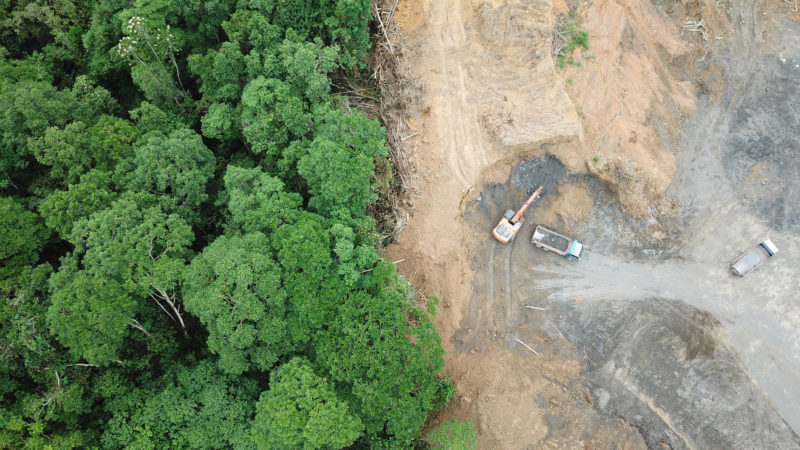Saving the tropical rainforests is not something the construction industry is typically asked to do. Providing high paying jobs? Yes, that’s something it does. Ensuring construction equipment fleets utilize the most environmentally friendly diesel engines? Yep, it does that too.
Ensuring stormwater run-off from construction sites is either filtered or completely avoids California’s waterways? Well yes, it even does that.
But the industry has not, until now, been asked to reduce tropical rainforest deforestation. And before you scratch your head and ask that inevitable question, “How?” it’s important to understand the critical role the world’s rainforests play in our global ecosystem.
Plants convert light and carbon dioxide into oxygen and sugar. The chlorophyll in plants (that’s what makes a plant look green) absorbs sunlight and uses the energy to convert six molecules of carbon dioxide and six molecules of water into one molecule of sugar and six molecules of oxygen.
Yes, that’s the same oxygen we humans breathe.
Now stay with me here. I know; it’s been a long time since I’ve had a biology or chemistry class, too. But these concepts are not too complex. Think of the photosynthesis process on a grand scale, like Amazon Rainforest grand. And think of them as massive generators of oxygen. A 2013 Foreign Affairs article, “A Light in the Forest, Brazil’s Fight to Save the Amazon and Climate-Change Diplomacy” paints a vivid picture of the function of a rainforest, in this case, the Amazon Rainforest:
“Think of the rainforest not as a collection of trees but as a hydrologic system, a massive machine for transporting and recycling water in which trees act as pumps, pulling water out of the ground then injecting it, through transpiration, into the air. This process ramps up as the sun rises over the Amazon each day. As the forest heats up, evaporation increases, and trees transpire to stay cool, simultaneously increasing the amount of water they take up through their roots. By constantly replenishing the atmosphere with water vapor, the Amazon helps keep its own weather on a grand scale.”
It also pulls all that carbon dioxide out of the atmosphere with sunlight and the magic of photosynthesis. Since rainforests make up 13 percent or about 7.7 million square miles of the land area of the earth, we’re talking about a very significant ability to convert carbon dioxide to oxygen.
As undeveloped countries log and remove their rainforests, the planet loses its ability to convert carbon dioxide and, as many scientists suspect, the increased carbon dioxide levels are causing the climate to change.
Hence, rainforests are extremely important to our planet’s worldwide ecosystem because they are a leading part of the world’s oxygen generation system. That’s why international accords, such as the Paris Agreement from 2016 and the United Nations Framework Convention on Climate Change from 1992, encourage the sustainable usage of the world’s rainforests.
Now, here’s the part you’ve been waiting for – how does this impact the construction industry in California?
On February 14, 2019, Assemblymember Ash Kalra (D-San Jose), introduced legislation, AB 572, which requires contractors to certify that the wood procured for public works contracts did not contribute in whole or in part to tropical deforestation or illegal land conversion.
The bill also requires contractors to develop and maintain a “No Deforestation, No Peat, No Exploitation” policy consisting of a description of the complete supply chain for the wood product, what was done to ensure the product does not contribute to the deforestation of forests, the measures taken to ensure the indigenous people were informed, and the measures taken to protect the biodiversity and wildlife. It also requires contractors to show evidence that the contractor is monitoring and progressing in the policy’s implementation. By showing “progress,” I suppose the author doesn’t think AB 572 is entirely achievable.
It’s literally impossible for a contractor to certify that the wood product used to form concrete on a Caltrans project did not originate from a tropical tree due to clear-cutting or deforestation. The only way to completely guarantee that it didn’t would be for the contractor to travel with the loggers and follow the wood from the source to the public works job site.
That’s unrealistic.
Not surprisingly, this is not the first time the legislature dabbled in requiring contractors to certify that a project’s source materials did not originate from unsustainable or illegal means.
In 2011, SB 1231 by then-Senator Ellen Corbett (D-San Leandro) was opposed by SCCA and ultimately defeated. That bill would have required contractors to certify that any materials used on the job were not produced by slave labor, convict labor or child labor. Material, such as the bitumen used in asphalt, is a petroleum product that may have originated from Venezuela. How can a contractor ensure fair labor was used in the production of Venezuelan petroleum? It can’t. Rainforests are very important to our world’s ecosystem. But to what extent should the state go to protect them? AB 572 goes too far. The author’s office clearly is attempting to reduce the demand for these products. His efforts would be more effective working with U.S. Customs to ensure wood products didn’t originate from the world’s rainforests. SCCA strongly opposes AB 572. It would simply delay projects and encourage lawsuits, and it would do very little to protect our world’s ecosystem.


